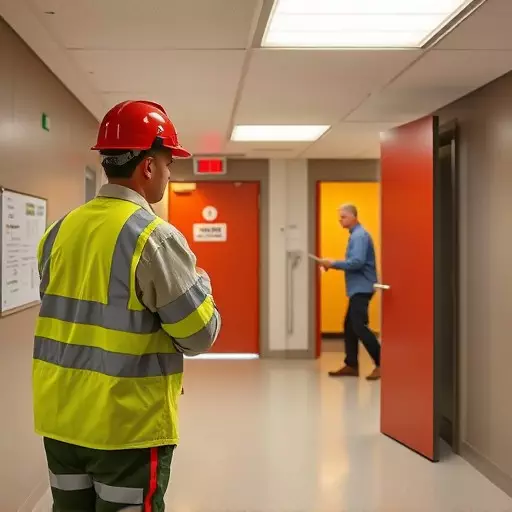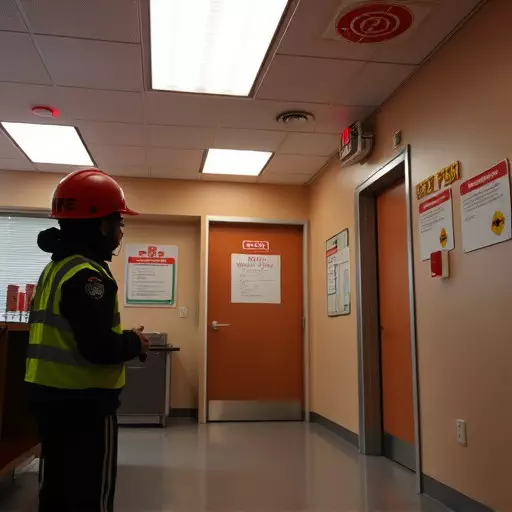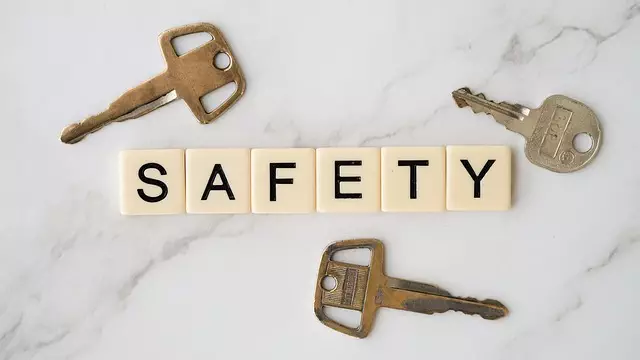Digital transformation in emergency workplace safety training, including fire safety and evacuation drills, leverages interactive platforms with VR/AR to enhance employee preparedness. While these technologies offer engaging, accessible learning experiences, challenges like remote worker inclusion and virtual hands-on limitations must be addressed through strategic integration with traditional methods. This holistic approach fosters proactive safety cultures, optimizing training programs for improved readiness and potentially saving lives during emergencies. (Keywords: emergency workplace safety training, workplace evacuation drills, fire safety training)
In today’s digital era, the shift towards technology integration in safety training is not just a trend but a necessity. This article explores the transformative potential of digital tools in enhancing critical aspects of emergency workplace safety training, particularly focusing on fire safety and evacuation drills. We delve into the benefits and challenges of this shift, examining how interactive platforms and virtual reality simulations improve response times, awareness, and overall preparedness.
- Understanding the Shift to Digital Training: Benefits and Challenges
- Emergency Workplace Safety Training: Integrating Technology for Real-Time Response
- Simulating Scenarios: Enhancing Fire Safety Training with Virtual Reality
- The Role of Interactive Platforms in Effective Workplace Evacuation Drills
- Measuring Success: Tracking and Evaluating Technology's Impact on Safety Awareness
Understanding the Shift to Digital Training: Benefits and Challenges

The shift towards digital training in emergency workplace safety, including fire safety training and workplace evacuation drills, is a significant evolution in how organizations ensure employee preparedness. This transition from traditional classroom settings to virtual platforms offers numerous advantages. For instance, digital training allows for flexible learning experiences, accommodating diverse schedules and remote workers. Interactive simulations and multimedia resources can enhance knowledge retention, making these sessions more engaging and effective. Additionally, digital platforms provide easy access to up-to-date information, ensuring employees are equipped with the latest safety protocols.
However, challenges accompany this shift. One significant hurdle is ensuring equal accessibility for all staff, especially those in remote or diverse work environments. Digital training requires reliable technology and internet connectivity, which may not always be available. Moreover, while digital formats can improve engagement, they might not replace the hands-on nature of certain safety practices, particularly in high-risk industries. Therefore, a successful integration strategy must balance these benefits and challenges to create an inclusive, effective, and complementary training experience.
Emergency Workplace Safety Training: Integrating Technology for Real-Time Response

In today’s digital era, the integration of technology in emergency workplace safety training is transforming traditional methods into dynamic, interactive experiences. Virtual reality (VR) simulations and augmented reality (AR) applications are revolutionizing how employees prepare for potential hazards like fires or natural disasters. These immersive tools allow trainees to practice evacuation routes, identify safety equipment, and respond to critical situations in a controlled environment, enhancing their awareness and readiness.
Moreover, digital platforms facilitate real-time scenario testing and immediate feedback, enabling managers to assess team preparedness and adjust training programs accordingly. This advanced approach to fire safety training and workplace evacuation drills goes beyond passive learning, fostering proactive safety cultures where every employee is equipped with the knowledge and skills needed for swift and effective responses during emergencies.
Simulating Scenarios: Enhancing Fire Safety Training with Virtual Reality

In today’s digital era, technology integration has revolutionized emergency workplace safety training, specifically fire safety training and workplace evacuation drills. Virtual reality (VR) is emerging as a powerful tool to simulate diverse fire scenarios, providing trainees with hands-on experiences in a controlled environment. This immersive approach enhances learning retention by allowing individuals to confront and navigate through fires, smoke, and evacuations without actual risk.
By replicating real-world conditions, VR offers a safe space for employees to practice decision-making skills, familiarize themselves with emergency equipment, and coordinate with colleagues during simulated workplace evacuation drills. Such realistic training contributes to quicker responses and improved overall safety during actual emergencies, ultimately saving lives and minimizing damage.
The Role of Interactive Platforms in Effective Workplace Evacuation Drills

In today’s digital era, the integration of technology in emergency workplace safety training has transformed traditional methods of fire safety training and workplace evacuation drills. Interactive platforms offer a dynamic and engaging approach, making complex scenarios more accessible and realistic for employees. By utilizing virtual reality (VR) or augmented reality (AR), trainees can experience simulated fires or emergencies, practicing evacuation routes and procedures in a safe and controlled environment. This immersive learning experience improves retention rates and fosters a deeper understanding of safety protocols.
These platforms allow for customized scenarios tailored to specific workplace layouts and potential hazards. Trainees can receive immediate feedback during drills, ensuring they are prepared for real-life situations. Interactive training also promotes active participation, encouraging employees to think critically and make informed decisions during an emergency. This technology revolutionizes fire safety training by providing a cost-effective, efficient way to ensure everyone is equipped with the necessary skills, enhancing overall workplace evacuation efficiency and potentially saving lives.
Measuring Success: Tracking and Evaluating Technology's Impact on Safety Awareness

Measuring Success: Tracking and Evaluating Technology’s Impact on Safety Awareness
In today’s digital era, technology integration in emergency workplace safety training has become a game-changer. Interactive simulations, virtual reality (VR), and augmented reality (AR) are enhancing traditional methods like fire safety training and workplace evacuation drills. These innovative tools enable employees to experience hazardous scenarios firsthand, fostering a deeper understanding of safety protocols.
To gauge the effectiveness of these technological interventions, regular tracking and evaluation are essential. Organizations can measure success by analyzing participant engagement, retention rates, and performance improvements in real-life situations, such as fire drills. Data-driven insights help identify areas for enhancement, ensuring continuous improvement in overall workplace safety awareness.


